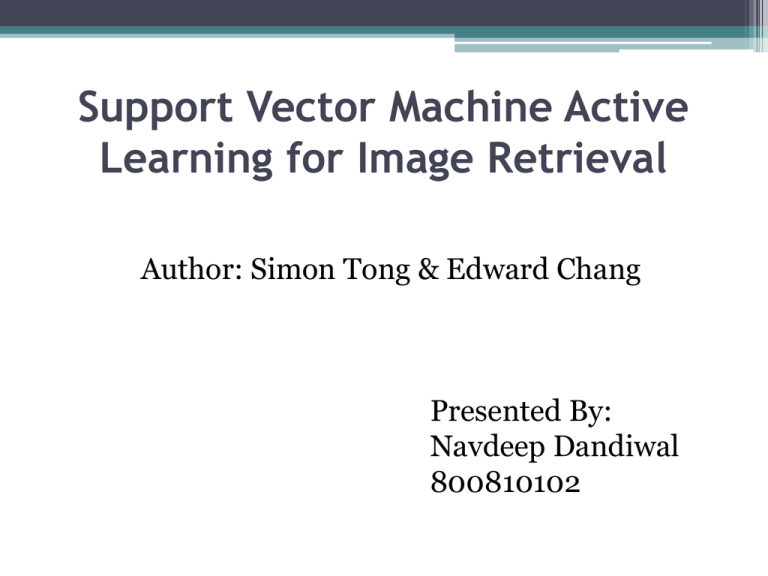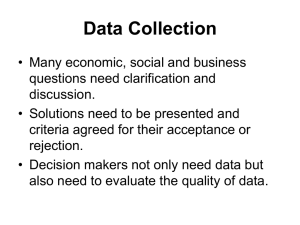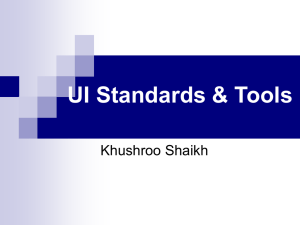Support Vector Machine Active Learning for Image Retrieval
advertisement

Support Vector Machine Active
Learning for Image Retrieval
Author: Simon Tong & Edward Chang
Presented By:
Navdeep Dandiwal
800810102
Content
Motivation
Introduction
SVM
Version Space
Active Learning
Image Characterization
Experimental Data
Conclusions
Motivation
Relevance feedback is often a critical component
when designing image databases.
Interactively determines a user’s desired output
by asking user to label images
Can it get boring for the user?
How to create effective relevance feedback?
Abstract
The proposed use of Support Vector Machine
Active Learning Algorithm is: Effective relevance feedback by grasping user’s
query concept accurately and quickly, while asking
to label small number of images
Selects the most informative images to query a
user
Quickly learns boundary that separates the images
that satisfy the user‘s query concept from the rest
of the dataset
Introduction
User should be able to implicitly inform a
database of his or her desired output or query
concept
Relevance feedback can be used as a query
Refinement Scheme to learn user query concept
Based on the answers, another image set is
brought up for user to label
We call such refinement scheme as
query concept learner
Introduction(contd…)
Refinement Scheme
Fetches few image instances
User labels each instance
Relevant images
Irrelevant images
Introduction(contd…)
Most machine learning
algorithms are passive
Passive in the sense
that they are generally
applied using
randomly selected
training set
Key idea of active
learning
It should be able to
choose its next poolquery based upon the
past answers to
previous pool-queries
Introduction(contd…)
Support Vector Machine Active
Learner(SVMActive). It works on following ideas:
Similar to learning SVM binary classifier where a
hyperplane separates relevant and irrelevant
images in a projected space.
Learns the classifier quickly via active learning
Returns top-k most relevant images. These are
the ones farthest from the hyperplane
Support Vector Machines
In their simplest forms, SVMs are hyperplanes
that separate the training data by maximal
margin
All vectors on one side of hyperplane are labeled
as ‘-1’ and on the other side as ‘1’
Training instances that lie closest to the
hyperplanes are called support vectors
Support Vector Machines(contd…)
- Support vectors
Given training data {x1 . . . xn} that are vectors in some space
We also give their labels {y1 . . . yn} where yi {-1,1}
Support Vector Machines(contd…)
SVMs allow one to project the original training
data in space to a higher dimensional feature
space via a Mercers kernel operator K.
When
we classify x as +1, otherwise as -1
Support Vector Machines(contd…)
Support Vector Machines(contd…)
When K satisfies Mercer’s condition it can be
written as
and “.” denotes inner product. We can write f as:
Thus by using K we are implicitly projecting the
training data into a different (often higher
dimensional) space F
Version Space
Version Space(contd…)
Given a labeled training data and a Mercer
kernel K , then the set of consistent hyperplanes
that separate the data in the induced feature
space is called the version space
Our set of possible hypothesis is given as:
Where parameter space
is simply equal to
Version Space(contd…)
The version space,
is defined as:
Notice that is a set of hyperplanes, there is a
exact correspondence between unit vectors w
and hypothesis f in . Thus we will redefine
as:
Version Space(contd…)
SVMs find the hyperplane that maximizes the
margin in feature space . One way to pose this
as follows:
subject to:
Cause solution
to lie in version
space
Version Space(contd…)
We want to find the point in the version space
that maximizes the minimum distance to any of
the delineating hyperplanes.
Largest sphere whose
center lies in version space
and whose surface does not
intersect with the
hyperplanes.
It’s center corresponds
to SVM and radius is
the margin of SVM in
feature space
Active Learning
In pool based active learning we have a pool of
unlabeled instances
Instances x are independently and identically
distributed according to underlying function
F(x)
Labels are distributed according to some
conditional distribution P(y|x)
Active Learning(contd…)
Given unlabeled pool U
Active learner l: (f, q, X)
Classifier f
Querying function q(X)
Labeled data X
Given current labeled set X,
decides which instance in U to
query next
Can also return a classifier f
after each or fixed number of
pool-queries
Difference between
active and passive
classifier
Active Learning(contd…)
How to choose the next unlabeled instance in the
pool to query?
Use approach that queries points so as to
attempt to reduce the size of the version space as
much as possible
Active Learning(contd…)
-The surface of the hypersphere represents unit weight vectors
-Each of the two hyperplanes corresponds to a labeled training instance
-Version space is the surface segment closest to the camera
Active Learning(contd…)
-A large sphere could be embedded
-The center of this sphere lies in version space and surface does not
intersect with the hyperplanes
-Center is SVM, radius is margin
Active Learning(contd…)
Reduce version space as fast as possible by
choosing a pool-query that halves V
Next pool-query
Unlabeled instances
Labeled instances
wi
Largest
hypersphere that
fits inside
version space
SVM
Version space
Active Learning(contd…)
SVMActive takes simple approach chooses pool
query of twenty images closest to its separating
hyperplane
It can be unstable during first round of RF
Therefore choose random images for the first
round
SVMActive Algorithm
Learn SVM on
current labeled data
Is it first
feedback
round?
yes
no
Ask user to label 20
pool images closest to
SVM boundary
Ask user to label 20
randomly selected images
Learn final SVM on
labeled data
Display top-k relevant
images, farthest from SVM
After relevance
feedback rounds
Image Characterization
Our system employs a multi-resolution image
representation scheme.
In this scheme, we characterize images by two
main features:
Color
Texture
We consider shape as the attribute of these main
features
Image Characterization(contd…)
Multi-resolution Color Features
Image Characterization(contd…)
Multi-resolution Texture Features
Three characterizing texture features:
Structuredness
Orientation
Scale
Discrete Wavelet Transformation (DWT) using
quadrature mirror filters because of its
computational efficiency
Image Characterization(contd…)
Multi-resolution Texture Features
Image Characterization(contd…)
Color
Texture
extraction
144 dimensional vector
Space for SVMActive is a 144 dimensional space
Each image in database corresponds to a point
in this space
Experiments
4-category; 10-category; 15-category datasets
To enable objective measure of performance, it
is assumed that a query concept was an image
category
Accuracy is computed by looking at the fraction
of the k returned result that belongs to the target
image category
All SVM algorithms require at least one relevant
and one irrelevant image to function
Experiments(contd…)
4-category set
10-category set
15-category set
Experiments(contd…)
SVMActive displays 20 images per pool-querying
round
The trade-off
Number of
images in one
round
Keeping it constant
fewer
Number of
querying
rounds
Performance
lower
Experiments(contd…)
20 random +
2 rounds of
10
vs
20 random +
1 rounds of
20
Because active learner has more
control and freedom to adapt when
asking two rounds of 10 images
than one round of 20 images
20 random +
2 rounds of
20
vs
20 random +
2 rounds of
10
-Increase in cost of asking 20
images per round to user is
negligible, since user can pick out
relevant images easily
-Virtually no additional
computational cost in calculating
the 20 images to query
Experiments(contd…)
SVMActive displays 20 images per pool-querying
round
The trade-off
Number of
images in one
round
Keeping it constant
Performance
Number of
querying
rounds
conduct more
rounds
increase
Experiments(contd…)
Active and regular passive learning on 15-category dataset
After three rounds of querying
After five rounds of querying
Experiments(contd…)
Average top-50 accuracy over the 4category data set using a regular SVM
trained on 30 images
Accuracy on 4-category data set after three
querying rounds using various kernels
Experiments(contd…)
Scheme comparison
Other Schemes(QPM; QEX)
Traditional information retrieval schemes
require a large number of image instances to
achieve any substantial refinement
Tend to be fairly localized in their exploration of
the image space and hence rather slow in
exploring the entire space
Experiments(contd…)
Scheme comparison
SVMActive
During relevance feedback, it takes both the
relevant and irrelevant images into account
when choosing the next pool-queries
Chooses to ask user to label images that are
regarded most informative for leaning the query
concept, rather than relying on the likelihood of
being relevant
Experiments(contd…)
Average top-k accuracy over the 15-category dataset
Conclusions
In a nut shell the contributions of this study are:
SVMActive can produce a well suited learner
that significantly outperforms traditional
methods
Organizing image features in different
resolutions gives learner the flexibility to
model subjective perception and to satisfy a
variety of search tasks.
Conclusions(contd…)
Running time of SVMActive algorithm scales
linearly with the size of image database.
Solution:
Subsampling databases – using few thousand
images as pool with which to query user
Designing methods to seed algorithms
It would be beneficial to make SVMActive
independent of having a starting relevant image
Resources
http://courses.cms.caltech.edu/cs101.2/slides/c
s101.2-09-svm-active-learning.pdf
http://airccse.org/journal/sipij/papers/3112sipi
j04.pdf








